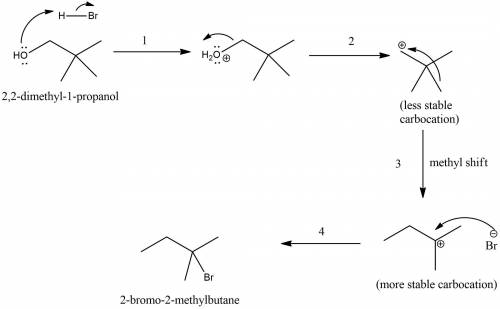
Chemistry, 17.12.2019 04:31 coolquezzie
The reaction of 2,2-dimethyl-1-piopanol with hbr is very slow and gives 2-bromo- 2-methyibutane as the major product. give a mechanistic explanation for these observations. select all that apply. stereoelectronic effects result in an antic op lanar rearrangement of the carbon skeleton. steric hindrance prevents nucleophilic attack. the mechanism requites the development of an unstable positively charged species in the transition state. the mechanism results in a carbocation rearrangement in which a methyl shift occurs. the mechanism requires dissociation of a poor leaving group.

Answers: 3


Another question on Chemistry

Chemistry, 21.06.2019 18:20
Complete the table for ion charge based upon their losing or gaining electrons in the outer shell. (use the periodic table as necessary.) group most likely ionic charge # of valence electrons i +1 ii +2 iii +3 iv +4 or -4 v -3 vi -2 vii -1 viii 0
Answers: 2

Chemistry, 21.06.2019 20:30
In a laboratory experiment, a fermenting aqueous solution of glucose and yeast produces carbon dioxide gas and ethanol. the solution was heated by burning natural gas in a bunsen burner to distill the ethanol that formed in the flask. during the distillation, the ethanol evaporated and then condensed in the receiving flask. the flame of the burner was kept too close to the bottom of the flask and some of the glucose decomposed into a black carbon deposit on the inside of the flask. during this experiment the following changes occurred. which of these changes involved a physical change and not a chemical change? check all that apply. 1-condensation of ethanol 2-evaporation of ethanol 3- formation of carbon dioxide gas from glucose burning of natural gas 4-formation of ethanol from glucose by yeast 5-formation of a carbon deposit inside the flask
Answers: 2

Chemistry, 22.06.2019 04:00
How do scientists think that gravity affected the formation of our solar system?
Answers: 1

Chemistry, 22.06.2019 06:30
The following reaction shows the products when sulfuric acid and aluminum hydroxide react. al(oh)3 + h2so4 → al2(so4)3 + h2o the table shows the calculated amounts of reactants and products when the reaction was conducted in a laboratory. sulfuric acid aluminum hydroxide initial amount of reactant 40 g 15 g theoretical yield of water from reactant 14.69 g 10.38 g what is the approximate amount of the leftover reactant? 11.73 g of sulfuric acid 10.33 g of sulfuric acid 11.12 g of aluminum hydroxide 13.67 g of aluminum hydroxide
Answers: 3
You know the right answer?
The reaction of 2,2-dimethyl-1-piopanol with hbr is very slow and gives 2-bromo- 2-methyibutane as t...
Questions


Mathematics, 13.10.2019 03:30




Physics, 13.10.2019 03:30


Mathematics, 13.10.2019 03:30


Mathematics, 13.10.2019 03:30

Biology, 13.10.2019 03:30


History, 13.10.2019 03:30


Spanish, 13.10.2019 03:30

Health, 13.10.2019 03:30



Mathematics, 13.10.2019 03:30

Mathematics, 13.10.2019 03:30

 .
. attacks the stable carbocation to produce 2-bromo-2-methylbutane.
attacks the stable carbocation to produce 2-bromo-2-methylbutane.


